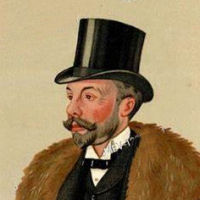| Handout (flat) Handout (folded) Class Script | Return to Index |
VIDEO LINKS
We are very much in luck this week! Everything shown in class is currently available on YouTube, plus much else besides. The 2015 revival of the Jonathan Miller production at the ENO, which was the featured work, is available complete, in good quality, and with titles. Most of the other productions I referenced are available complete also; see the first section below.
I was thrilled to see that Mike Leigh's 1999 film Topsy Turvy is also available complete. It is a marvelous and detailed dramatisation of the genesis of The Mikado, and is both trustworthy and informative. The first two links are to the clips shown in class. The third link is to a longer section devoted to Mikado rehearsals, which is very funny. But really the whole thing is worth watching in full.
In addition to the two versions of Ko-Ko's list song I played in class, I have added the video and text of Eric Idle's version in the original 1987 Miller production, plus one other with an Australian spin and a hilarious parody from Family Guy; don't miss it!
Under the heading of Cultural Appropriation, I posted the three openings I showed in class, plus the one from Stratford, Ontario, as an example of Japanese elements used as part of a sophisticated design concept. At the opposite end of the scale, I include the opening from the Auckland production that gives the whole thing a Maori spin; it was too radical a departure from the original to show in class. More radical still is a video from G&S Austin called "A Fresh Take on Three Little Maids" that takes diversity just about as far as it will go. And, oh yes, I threw in the complete Katy Perry Asian-themed performance that I used in my title video. All three of these need to be seen to be believed!
*Asterisks indicate clips not played in class.
| COMPLETE PERFORMANCES | |||
| D'Oyly Carte 1966 | * complete (the traditional approach preserved) | ||
| Stratford 1982 | * complete | ||
| Auckland 1996 | * complete (more of an adaptation; see below) | ||
| Melbourne 2011 | * complete (contextualized in Victorian theatre) | ||
| ENO 2015 | * complete, with titles (the Jonathan Miller production featured in class) | ||
| AN IMAGINED JAPAN | |||
| Yum-Yum's song | * The sun whose rays (Valerie Masterson, 1966) | ||
| Topsy Turvy |
* 1999 film complete
(Mike Leigh, director) * — clip shown in class 1 * — clip shown in class 2 * — The Mikado in Rehearsal |
||
| ENGLAND ABSURD | |||
| Pooh-Bah's speech | * Stratford 1982 (Richard McMillan) | ||
| Ko-Ko's little list |
* D'Oyly Carte 1966
(John Reed) * ENO 1987 (Eric Idle; text is here) * Melbourne 2011 (Mitchell Butel) * ENO 2015 (Richard Suart) * Family Guy parody |
||
| LET'S TALK ABOUT CULTURAL APPROPRIATION | |||
| Opening scenes |
* D'Oyly Carte 1966 * Stratford 1982 * PBS 1983 * Auckland 1996 (with Maori haka additions!) * Melbourne 2011 |
||
| Other clips |
* A fresh take on The Mikado
(GS Austin, see note above) * Katy Perry: "Unconditionally" (used in title montage) |
||

























